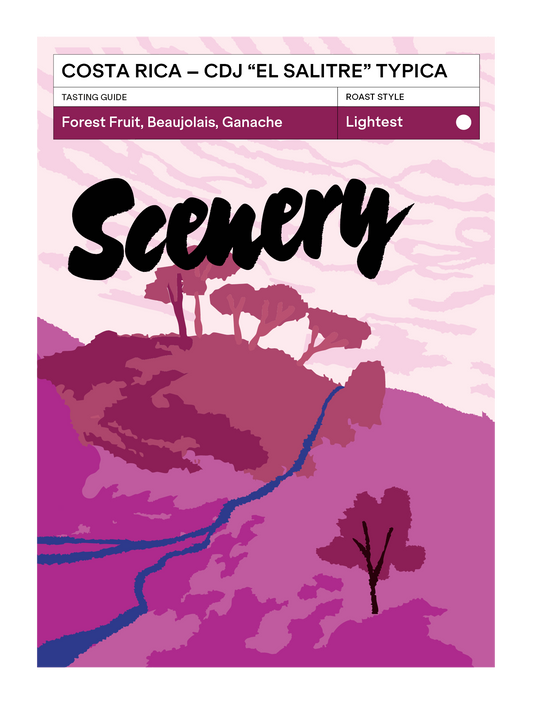*Last Batch Roasted 17/06/25*
Contrasting the ultra-clean floral presentation from Rumudamo, we've another special prep from Ethiopia - the return of an absolute sizzler from the "King of Guji" himself - Ture Waji. This lot banged last year and we've unfortunately only managed to secure half as much as last season - so this won't be sitting around for long.
This special prep was completed at the Suke station with cherries from smallholders in the Shoondhisa kebele.
Brew Guide:
Best Brewed with: Filter
Lightest Influence: A very low end temperature keeps maximum acidity and cleanliness; but not so fast of a roast it picks up any scratchy elements.
Best Rested: 3-4 weeks
Filter: 65g/L, 98°C & coarser when fresh but when well rested you can go to 62g/L 92-93°C
Espresso: 18g/50g/20s - turbo shots. May have enough fines generation to run a tighter yield, but will be quite acid forward
We’re tasting: Tinned fruit cocktail aromatics alongside kiwi, passionfruit, & grapefruit mountain pepper. In the cup - while hot it's big gummy sweet vibes. As it cools, a bit more elegance comes to the fore - ripe papaya, passionfruit, blueberry jam, lavender florals and the process style asserting itself with slightly boozy macerated fruit, like a fruity Pimm's cup.
Traceability
Country of Origin: |
Ethiopia |
Region: |
Suke Quto, Shakiso, Guji |
Producer: |
Ture Waji & 35 smallholders in Shoondhisa |
Station: |
Suke |
Variety: |
JARC 74110 & 74112 |
Elevation: |
2000-2200 MASL |
Process: |
Anoxic Natural: Ripe cherries hand picked and sorted. Placed inside sealed grain-pro bags and dry fermented in an anoxic environment. Following this, dried as a natural on raised beds over 25 days |
Import Partner: |
Osito via Sookoo Coffee |
Harvest |
Crop 24/25, Arrived UK: May 21st 2025 |
The Story
We've featured coffees from Ture Waji's Sookoo coffee for three seasons now - a past-crop lot in our first year of facility, this anoxic lot last year, and now we're featuring a Bookkisa double bill in Colourful V10 alongside the return of this special prep. They're really good - we should & will buy more moving forward.
Having sourced some special processed lots last year and having absolutely loved them; we've gone hard this year - working with trusted suppliers to bring some rare and unusual bangers.
The Ethiopian government's continued minimum price floors for exported "anaerobic" naturals - initially implemented to bring in more foreign currency from exports - have maintained elevated pricing for these special preparations. However, the dramatic correction in cherry prices this season (dropping from the 65-105 birr/kg chaos of 2023 to more sustainable 25-45 birr/kg levels) has created better market conditions, even as international C-prices hit historic highs above $4/lb. You may note that pricing is up this year - this lot was 25% more expensive for us to purchase this season.
The 24/25 harvest has been a game-changer for Ethiopian coffee quality. After years of volume-driven pricing that didn't incentivize quality practices, this season's market correction has restored focus to premium processing. The favourable weather conditions - particularly the consistent six-month rainfall in Guji from August to January - have delivered both increased volume (8.5 million bags projected) and significantly improved cup quality. This lot from Osito represents exactly what we hoped to see: the quality improvements that many predicted would emerge once the market stabilized.
The fact this coffee shipped earlier in the season was a bonus for us. Early-season arrivals like this maintain that extra vibrancy and immediacy that comes from shorter time between harvest and roasting. This lot from Osito represents exactly what we hoped to see from the 24/25 harvest: the quality improvements that many predicted would emerge once the market stabilized, combined with Ture Waji's consistently excellent processing standards.
This lot was processed at the Suke station in Shakiso, Guji. The cherry came from smallholders in the Shoondhisa kebele - and for the heads that know the profile this micro-region produces, you'll see why this caught our eye. Famously known for exceptionally berry-dominant coffees, the extra processing step of holding the cherry in grain-pro (hermetically sealed, food-grade plastic bags used typically to transport green coffee) for 86 hours before drying just amplifies all the big bold natural notes we're looking for. The warm climate, retained moisture from the cherries and low oxygen environment created inside the grain-pro promotes an entirely different microbial environment for fermentation, those altered communities and metabolic pathways creating complex flavour compounds and pre-cursors.
This initial intervention has significant results in the final cup even after the coffee is finished via "natural" drying, the environment shifting as the moisture leaves and yeast become dominant on the skins of the fruit. Done badly, a coffee like this picks up the rotten fruit character or as it's more commonly known - bin juice. Executed well - papaya, blueberry pie and intensely complex, with all the baseline flavours of the micro-region serving as a foundation for additional flavours created through complex wild fermentation.

![[70] Ethiopia - Ture Waji's Anoxic Natural [CROP 24/25 ARCHIVE]](http://scenery.coffee/cdn/shop/articles/ethiopia_ture_waji_2425_shopify_7c90b2eb-a425-489d-8293-98db8bb599fa.png?v=1752833642&width=1100)
![Colombia - Quebraditas Ají Thermal Shock Washed [FESTIVE SPECIAL] 🎄](http://scenery.coffee/cdn/shop/files/colombia_quebraditas_aji_shopify.png?v=1764358600&width=533)






![Colombia - Quebraditas Sidra Thermal Shock Washed [25/26]](http://scenery.coffee/cdn/shop/files/colombia_quebraditas_sidra_2526_shopify.png?v=1765544630&width=533)



![Colombia - Luz Ángela's Chiroso [25/26]](http://scenery.coffee/cdn/shop/files/colombia_luz_angela_chiroso_2526_shopify.png?v=1764359755&width=533)


![Colombia - El Jaragual Rosado [25/26]](http://scenery.coffee/cdn/shop/files/el_jaragual_rosado_2526.png?v=1757075842&width=533)